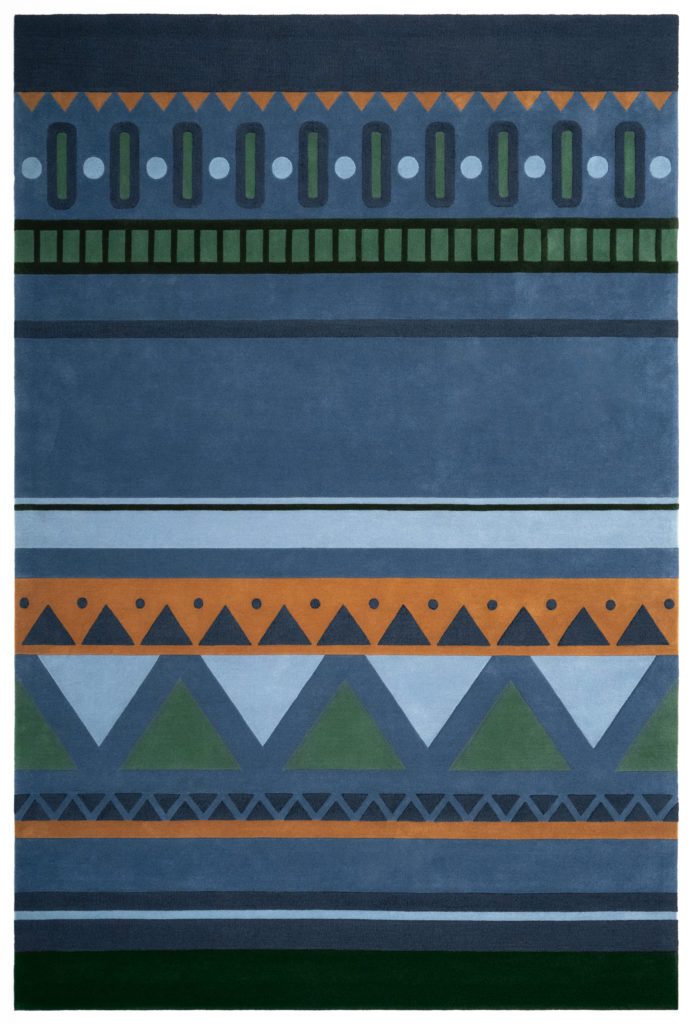For over six years, New Zealand/Samoan textile designer Lucy Tupu has been creating unique rugs in New York City, that reference her cultural heritage. On the eve of Lucy launching her first international studio here in Aotearoa, HOME discussed the influences and aspirations that fuel this expat.

Colour, pattern and a certain amount of nostalgia for New Zealand seem to be driving forces of your designs, is that fair to say?
Lucy Tupu: Yes, looking at my work as a whole, it becomes obvious that I grew up in 1970’s New Zealand! Our home was filled with so much kitsch – floral, beige wallpaper accented with heavy linen curtains and velvet, brown couches… a lemon-yellow vanity and matching acrylic shag-pile carpet in the bathroom… And when you layer in my Samoan heritage, you get to the heart of what our studio represents.
Even the way I approach naming each design is a nostalgic reference back to my childhood. For example the Falelima collection is named after my father’s village in Samoa and draws upon the strong graphic language of the tatau, with the rich blues and lush greens of Polynesia. My father designed my tatau so the symbolism of family, growth, travel and self-discovery takes on even more significance for me.

How do you arrive at any particular design, what is your creative process like?
I start by casting a wide net – from researching the fine details of ceramics and upholstery fabrics of that era to referencing New Zealand’s native birds, flora and fauna. I then pull in the elements that most resonate with me, honing the colours and designs further. I keep refining the concept until at some point I pause and make the decision that it’s ready to present.
Tell us about the textiles you use and what is your favourite?
I love to work with sustainable textiles, such as tencel or cactus, and natural fibres like New Zealand wool which are renewable, biodegradable, allergy-safe and inherently stain-resistant. However, my favourite approach is using a mash-up of materials, colours and textures to produce a unique multi-sensory experience. I might juxtapose something very thick and chunky, like felted New Zealand wool, alongside a very fine silk; choose contrasting colours, such as orange and pink; then mix textures by using varying pile heights to create a tactile, organic movement. I love to experiment!
For example, the Edna design – which was born out of a love for my great aunt’s costume jewellery and my passion for all things vintage – is fabricated with a delicate silk, on top of a wool field, allowing us to achieve the intricate details and movement of the jewelled motif. The Edna Multicolor rug also uses carving, beveling and an onyx-to-garnet ombré gradation to further play with texture and color.

How has the New Zealand/Samoan inspired design been accepted in NYC, any memorable places where your work has ended up?
I feel like any art that’s not widely known in the American mainstream is celebrated here – probably even more highly valued. So, yes, my New Zealand/Samoan aesthetic is really embraced.
The most memorable commercial space where my work has appeared is probably the storied Time-Life Building. It was an honour when the interior designers picked two of our rugs for their client’s headquarters. Custom designed in tonal grays and curving, gold lines, Moa was chosen for their elegant reception area while Waka was selected for their lounge.
We hear that you are launching a new collection this spring with a well-known New York visual artist and you are also launching a studio here in New Zealand… care to tell us more?
This artist and I were introduced six years ago and have become good friends supporting each other’s work. I’m in awe of his breadth of work, as well as the passion and intensity he puts into his art. I can’t give away too much at the moment, except that after sharing our designs and processes, we realised collaborating on a rug collection made perfect sense!
[In terms of the NZ studio] one of the pandemic’s silver linings was spending an extended period of time in New Zealand – from December 2020 to March 2021. An unexpected surprise was I found myself reconnecting on a deeper level with family, but also with my home country and its natural beauty. I realised how much “New Zealand” is who I am and what I do. Every detail, from the Samoan tapa cloth hanging in my parents’ home to the native Kowhai trees growing in their backyard, was inspiring and encouraged me to seek out what it is that makes me authentic… or rather what I do that’s authentic. The fact that our studio was forced to work remotely for over a year and we’re still here, made me realise that not only was it time to open a studio in New Zealand, but that it was actually possible.




